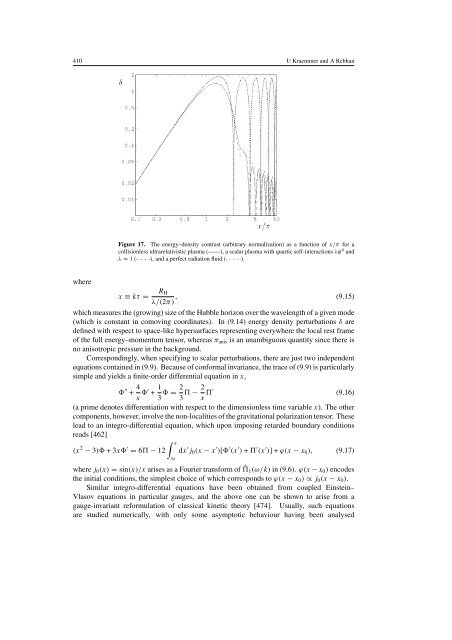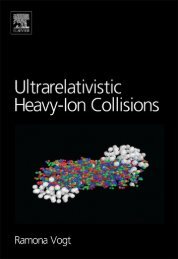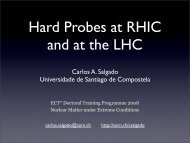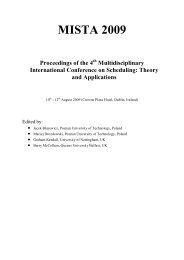Advances in perturbative thermal field theory - Ultra-relativistic ...
Advances in perturbative thermal field theory - Ultra-relativistic ...
Advances in perturbative thermal field theory - Ultra-relativistic ...
Create successful ePaper yourself
Turn your PDF publications into a flip-book with our unique Google optimized e-Paper software.
410 U Kraemmer and A Rebhan<br />
Figure 17. The energy–density contrast (arbitrary normalization) as a function of x/π for a<br />
collisionless ultra<strong>relativistic</strong> plasma (——), a scalar plasma with quartic self-<strong>in</strong>teractions λφ 4 and<br />
λ = 1 (- - - -), and a perfect radiation fluid (······).<br />
where<br />
x ≡ kτ =<br />
R H<br />
λ/(2π) , (9.15)<br />
which measures the (grow<strong>in</strong>g) size of the Hubble horizon over the wavelength of a given mode<br />
(which is constant <strong>in</strong> comov<strong>in</strong>g coord<strong>in</strong>ates). In (9.14) energy density perturbations δ are<br />
def<strong>in</strong>ed with respect to space-like hypersurfaces represent<strong>in</strong>g everywhere the local rest frame<br />
of the full energy–momentum tensor, whereas π anis is an unambiguous quantity s<strong>in</strong>ce there is<br />
no anisotropic pressure <strong>in</strong> the background.<br />
Correspond<strong>in</strong>gly, when specify<strong>in</strong>g to scalar perturbations, there are just two <strong>in</strong>dependent<br />
equations conta<strong>in</strong>ed <strong>in</strong> (9.9). Because of conformal <strong>in</strong>variance, the trace of (9.9) is particularly<br />
simple and yields a f<strong>in</strong>ite-order differential equation <strong>in</strong> x,<br />
′′ + 4 x ′ + 1 3 = 2 3 − 2 x ′ (9.16)<br />
(a prime denotes differentiation with respect to the dimensionless time variable x). The other<br />
components, however, <strong>in</strong>volve the non-localities of the gravitational polarization tensor. These<br />
lead to an <strong>in</strong>tegro-differential equation, which upon impos<strong>in</strong>g retarded boundary conditions<br />
reads [462]<br />
∫ x<br />
(x 2 − 3) +3x ′ = 6 − 12 dx ′ j 0 (x − x ′ )[ ′ (x ′ ) + ′ (x ′ )]+ϕ(x − x 0 ), (9.17)<br />
x 0<br />
where j 0 (x) = s<strong>in</strong>(x)/x arises as a Fourier transform of ˆ 1 (ω/k) <strong>in</strong> (9.6). ϕ(x − x 0 ) encodes<br />
the <strong>in</strong>itial conditions, the simplest choice of which corresponds to ϕ(x − x 0 ) ∝ j 0 (x − x 0 ).<br />
Similar <strong>in</strong>tegro-differential equations have been obta<strong>in</strong>ed from coupled E<strong>in</strong>ste<strong>in</strong>–<br />
Vlasov equations <strong>in</strong> particular gauges, and the above one can be shown to arise from a<br />
gauge-<strong>in</strong>variant reformulation of classical k<strong>in</strong>etic <strong>theory</strong> [474]. Usually, such equations<br />
are studied numerically, with only some asymptotic behaviour hav<strong>in</strong>g been analysed







